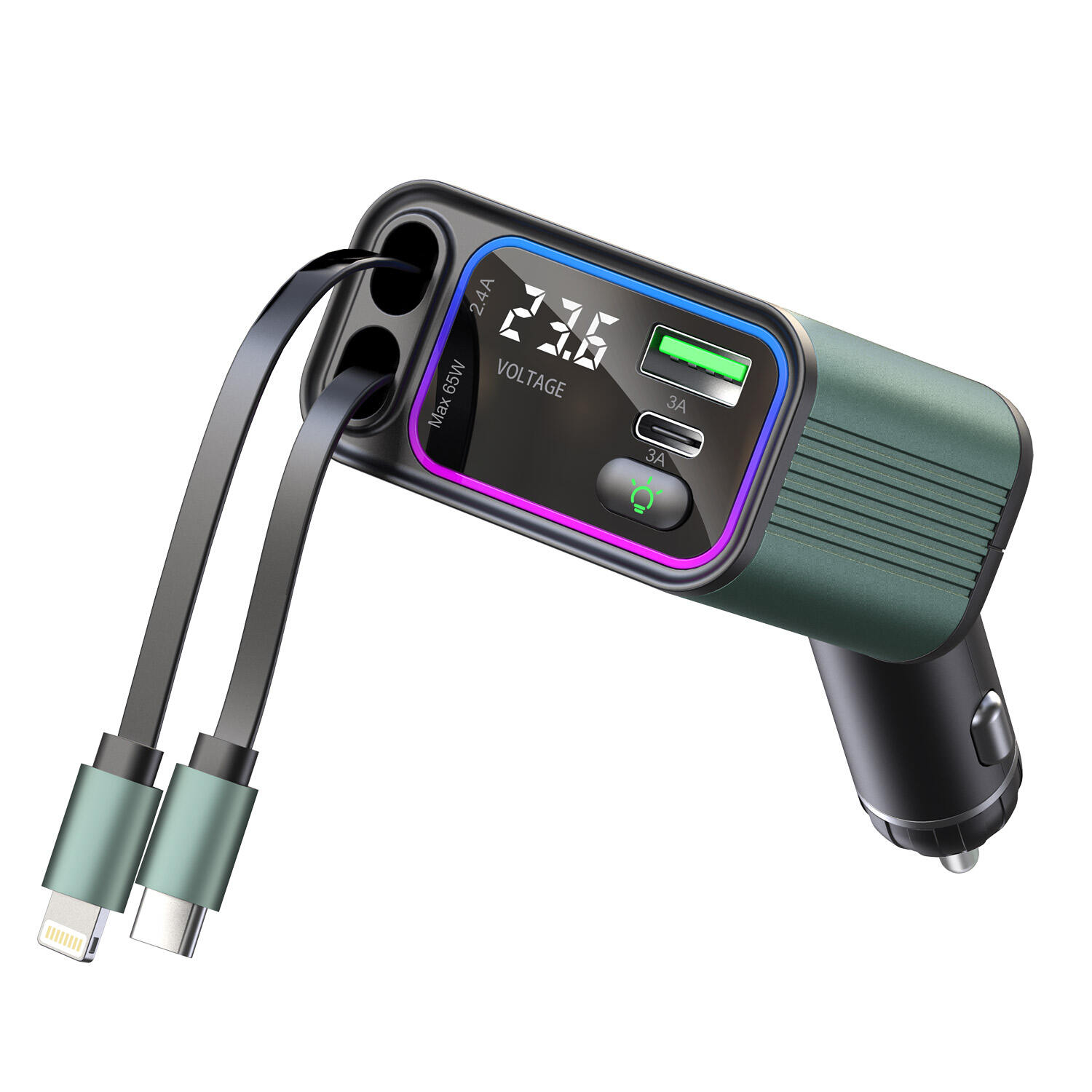Selecting the right universal car charger for your vehicle requires careful consideration of multiple compatibility factors that extend beyond simple plug-and-play assumptions. Modern vehicles feature increasingly sophisticated electrical systems that demand precise voltage matching, current ratings, and connector specifications to ensure safe and efficient charging performance. Understanding these technical requirements before making a purchase decision protects both your devices and your vehicle's electrical infrastructure while maximizing charging efficiency across all your electronic equipment.
The complexity of vehicle electrical systems varies significantly across different manufacturers, model years, and trim levels, creating potential compatibility challenges that require thorough evaluation. Professional automotive technicians recommend conducting comprehensive compatibility assessments before installing any aftermarket charging solutions to prevent electrical damage or performance issues. This systematic approach ensures optimal functionality while maintaining your vehicle's warranty coverage and safety standards throughout the installation and operation process.
Vehicle electrical systems typically operate on 12-volt DC power supplied through the cigarette lighter socket or dedicated accessory ports throughout the cabin area. However, actual voltage levels can fluctuate between 11.5 and 14.4 volts depending on engine operation status, alternator performance, and battery condition. A quality universal car charger must accommodate these voltage variations while maintaining stable output to connected devices.
Power output requirements depend entirely on the number and types of devices you plan to charge simultaneously through your charging solution. Smartphones typically require 5-15 watts for standard charging, while tablets demand 15-30 watts for optimal performance. Laptop computers and portable gaming devices may require 45-100 watts or more, necessitating higher-capacity charging solutions with appropriate power distribution capabilities across multiple output ports.
Most vehicle accessory circuits are protected by 15-20 amp fuses, establishing the maximum current draw available for aftermarket charging devices. Exceeding these amperage limits triggers fuse protection mechanisms, cutting power to the entire circuit until the fuse is replaced. Professional installation guidelines recommend calculating total amperage requirements for all connected devices plus a 20% safety margin to prevent circuit overload conditions.
Advanced charging solutions incorporate intelligent current distribution technology that monitors individual device requirements and adjusts power output accordingly. This smart charging capability prevents overloading while maximizing charging speed for each connected device. Circuit protection features including overcurrent protection, short circuit protection, and thermal protection safeguard both your devices and vehicle electrical system from potential damage caused by electrical faults or component failures.

Modern devices support various USB charging standards including USB-A, USB-C, Quick Charge, Power Delivery, and proprietary charging protocols developed by individual manufacturers. Universal car charger compatibility requires support for multiple charging standards to accommodate different device requirements effectively. USB-C Power Delivery protocol provides the most versatile charging solution, supporting power levels from 5 watts to 100 watts through intelligent negotiation between charger and device.
Backward compatibility ensures older devices continue functioning with newer charging technology, while forward compatibility provides upgrade pathways for future device acquisitions. Quality charging solutions feature automatic protocol detection that identifies connected devices and selects optimal charging parameters without user intervention. This intelligent approach maximizes charging efficiency while preventing damage from incompatible charging profiles or excessive power delivery.
Device connector variety includes Lightning connectors for Apple devices, USB-C for modern Android devices and laptops, Micro-USB for older electronics, and specialized connectors for specific equipment categories. Universal charging solutions must provide appropriate connector options through built-in cables, detachable cable systems, or multiple port configurations that accommodate various cable types simultaneously.
Cable quality significantly impacts charging performance and safety, with inferior cables causing voltage drops, reduced charging speeds, and potential safety hazards. Professional-grade cables feature proper gauge wiring, high-quality connectors, and appropriate shielding to maintain signal integrity and power delivery efficiency. Investing in certified cables from reputable manufacturers ensures compatibility and longevity while protecting valuable electronic devices from charging-related damage.
Vehicle interior design varies dramatically across manufacturers and model years, affecting universal car charger installation options and accessibility requirements. Some vehicles feature recessed cigarette lighter sockets that may not accommodate larger charging devices, while others provide multiple accessory ports in various locations throughout the cabin. Measuring socket dimensions and clearance requirements prevents compatibility issues and ensures proper fit during installation.
Accessibility considerations include driver and passenger reach requirements, visual obstruction of dashboard controls, and interference with gear shifter or other vehicle controls. Optimal mounting locations provide convenient access while maintaining safety and ergonomic principles. Extension cables or auxiliary mounting solutions may be necessary in vehicles with limited socket accessibility or inconvenient port locations.
High-power charging generates significant heat that must be dissipated effectively to prevent component damage and maintain charging efficiency. Vehicle interiors experience extreme temperature variations that can exacerbate heat buildup in electronic components. Quality universal car charger designs incorporate heat sinks, ventilation slots, or active cooling features to manage thermal conditions effectively.
Installation locations should provide adequate airflow around charging devices to support natural convection cooling. Enclosed storage compartments or tight spaces may trap heat and cause thermal protection circuits to activate, reducing charging performance or causing temporary shutdowns. Consider ventilation requirements when selecting mounting locations to ensure reliable operation across all environmental conditions.
Electrical protection systems safeguard both connected devices and vehicle electrical systems from damage caused by abnormal operating conditions. Overcurrent protection monitors amperage draw and automatically reduces or cuts power when safe limits are exceeded. Overvoltage protection prevents damage from alternator irregularities or electrical system faults that could deliver excessive voltage to sensitive electronic components.
Advanced protection circuits include surge protection that guards against voltage spikes caused by engine starting, alternator load changes, or external electrical interference. These protection mechanisms operate transparently during normal operation while providing crucial safety benefits during abnormal conditions. Quality charging solutions feature multiple protection layers that work together to ensure comprehensive safety coverage.
Thermal protection systems monitor component temperatures and implement protective measures when safe operating limits are approached. These systems may reduce charging current, activate warning indicators, or completely shut down charging operations to prevent component damage. Automatic recovery features restore normal operation once temperatures return to safe levels.
Environmental temperature considerations include both hot summer conditions and cold winter operations that can affect charging performance and component reliability. Quality universal car charger designs specify operating temperature ranges and include thermal compensation features that maintain optimal performance across environmental extremes. Understanding these temperature specifications ensures reliable operation in your specific climate conditions.
Intelligent power management systems optimize charging performance by dynamically allocating available power among connected devices based on their individual requirements and charging status. Priority-based charging algorithms ensure critical devices receive adequate power while maximizing overall system efficiency. These systems prevent power waste while maintaining optimal charging speeds for all connected equipment.
Load balancing features distribute power evenly across multiple ports when total device requirements exceed available capacity. This approach ensures all devices continue charging, albeit at reduced speeds, rather than cutting power to some devices entirely. Advanced systems provide visual indicators showing power distribution and charging status for each connected device.
Charging efficiency directly impacts vehicle battery drain during engine-off operation and overall energy consumption during normal driving. High-efficiency charging solutions minimize power waste through advanced switching technologies and optimized circuit designs. Efficiency ratings above 85% represent excellent performance, while ratings below 70% indicate excessive energy waste and potential battery drain concerns.
Energy conservation features include automatic shutdown when devices reach full charge, standby modes that minimize power consumption when no devices are connected, and intelligent wake-up systems that activate only when charging is needed. These features extend vehicle battery life during extended parking periods while ensuring devices remain ready for use when needed.
Look for universal car chargers that provide stable 5V, 9V, and 12V outputs to accommodate various device requirements. USB-C Power Delivery chargers offer the most versatility with variable voltage output ranging from 5V to 20V. Ensure the charger includes voltage regulation circuits to maintain stable output despite vehicle electrical system fluctuations.
Check your vehicle's accessory socket fuse rating, typically found in the owner's manual or fuse box diagram. Most vehicles support 10-20 amp loads through cigarette lighter sockets. Calculate total amperage requirements for your devices and ensure they remain below 80% of the fuse rating to prevent circuit overload and maintain safe operation margins.
Quality universal car chargers with proper safety certifications and intelligent charging protocols rarely damage devices due to built-in protection mechanisms. However, cheap chargers without proper voltage regulation or overcurrent protection can potentially damage sensitive electronics. Always choose chargers with UL, CE, or FCC certifications and appropriate safety features.
Prioritize total power output capacity, number and types of charging ports, intelligent power distribution, and comprehensive safety protection features. Look for chargers supporting multiple charging standards including USB-C Power Delivery, Quick Charge, and legacy USB protocols. Consider physical size, heat dissipation capabilities, and cable management features for your specific vehicle installation requirements.

Copyright © 2024 Shenzhen GXY Electronic Co.,LTD All Rights Reserved Privacy policy